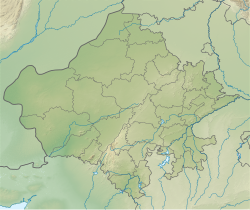This article contains promotional content. (November 2020) |
Delwara | |
|---|---|
Sub-Tehsil | |
| Nickname: "Devkul Patan Nagri" | |
| Coordinates: 24°46′31″N 73°44′47″E / 24.7752°N 73.7463°E | |
| Country | |
| State | Rajasthan |
| District | Rajsamand |
| Elevation | 586 m (1,923 ft) |
| Population (2011)[1] | |
• Total | 4,429 |
| Languages | |
| • Official | Hindi |
| • Additional Official | English |
| • Regional | Mewari |
| Time zone | UTC+5:30 (IST) |
| PIN | 313202 |
| Telephone code | +91- 2952 |
| Vehicle registration | RJ-30 |
| Nearest Places | Udaipur, Nathdwara, Rajsamand, Haldighati, Kumbhalgarh, Chittorgarh |
| Climate | BSh |
Delwara, nestled in the Aravalli Range hills, is a small town about 28 km away from Udaipur, Mewar (a former state in present-day Rajasthan), and close to Eklingji Temple, on the way to the temple town of Nathdwara, in the state of Rajasthan, India. Delwara was originally known as ‘Devkul Patan Nagri’ , which means the town of god.[citation needed] It boasted over 1500 temples at one time, out of which there were over 400 Jain temples.[citation needed] Delwara was the center of learning and culture before the 15th century AD. Around the middle of the 13th century, Raja Sagar, a Deora Chauhan and a descendant of Rao Kirtipal of Jalore, was a very brave king of Delwara (Mewar). Descendants of Raja Sagar sacrificed their lives while fighting alongside Ranas of Mewar against Muslim invaders.[citation needed] Raja Sagar was the progenitor of Bachhawat and Bothra clans of Oswals. Sagar's son, Kunwar Bohitya was immensely influenced and inspired by Jain philosophy. Samdhar, a grandson of Bohitya and a Deora Chauhan, was the first man in his genealogy to convert to Jainism.[citation needed]

